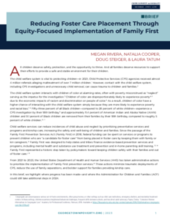From 2021 to 2023, the United States Department of Health and Human Services (HHS) has taken administrative actions to prioritize the implementation of Family First prevention services. These actions minimize traumatic deployments of CPS, reduce the use of family separations, and bolster support for families providing kinship care. In this brief, the authors highlight where progress has been made—and where the Administration for Children and Families (ACF) could still take additional steps in 2024.
The child welfare system has disproportionately failed AIAN, Black, and Latinx children and families. In recent decades, advocates and policymakers have worked to reorient the child welfare system away from a harmful overreliance on removing children from their homes and towards preventive services and programs that reduce abuse and neglect and support family and child well-being. Despite improvements over the years, the child welfare system remains inequitably intrusive and harmful to children and families of color, particularly where CPS investigations and home removal are involved.
Ongoing problems with the child welfare system, discussed in this section, include:
- The child welfare system disproportionately harms children of color and LGBTQ+ youth;
- Children and youth experience trauma when removed from parental care;
- Current preventative service spending does not sufficiently reduce family separation and foster care placement; and
- Slow approvals of evidence-based interventions have slowed the expansion of services supported by Family First.

